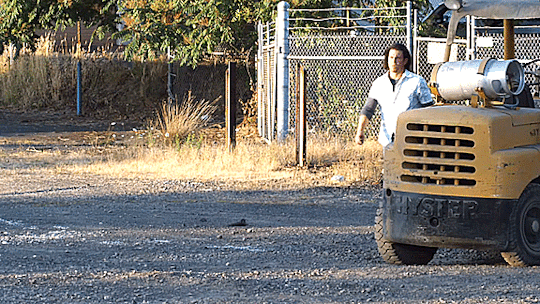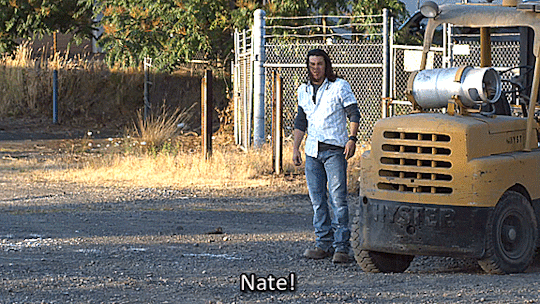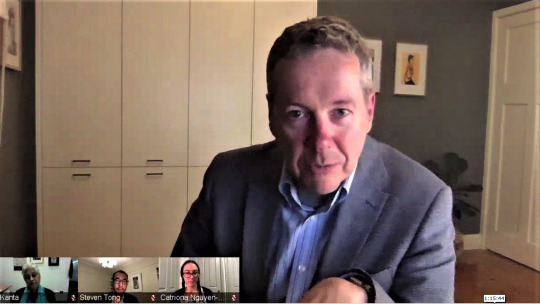#identify engage neutralise
Text
















Eliot protecting his crew.
Leverage S02E09 The Lost Heir Job.
#leverage#eliot spencer#parker#nate ford#christian kane#beth riesgraf#timothy hutton#the way his whole demeanour changes when he spots the gunman#the immediate shift into hitter mode#identify engage neutralise#whatever you do don't mess with his family#long post#tw blood#ghostly'sgifs
70 notes
·
View notes
Text
Army, Navy kill five IPOB fighters in Imo

Personnel of the Nigerian Army and the Nigerian Navy have killed five fighters of the Indigenous People of Biafra during a gun battle that occurred at Ejemekuru in Oguta Local Government Area of Imo State.
The encounter with IPOB’s fighters is coming a few days after a fierce gun duel between the troops and IPOB fighters occurred in the Orsu LG of the state.
The troops killed an IPOB fighter in the operation and recovered three Improvised Explosive Devices, one Toyota Highlander SUV, one Hilux vehicle, eight rounds of 7.62mm (Special) ammunition, among others from their hideouts.
As contained in a statement issued by the Director, Army Public Relations, Maj. Gen. Onyema Nwachukwu on Wednesday, the troops, during the combined operations, recovered one AK-47 rifle and two pump-action Semi-automatic rifles, among others.
The statement read, “In a successful raid operation conducted into identified IPOB/ESN camps on Tuesday 5 March 2024, combined Nigerian Army and Nigerian Navy troops have neutralised five armed fighters in a firefight that ensued at Ejemekuru in Oguta Local Government Area of Imo State.
“On overpowering the Armed separatists’ resistance with overwhelming firepower, the gallant troops recovered a significant cache of dangerous weapons including one AK-47 rifle, 2 Pump-action Semi-automatic rifles, one locally fabricated gun, 2 magazines, and 3 rounds of 7.62mm Special ammunition. The troops also recovered 2 motorbikes, 2 mobile handsets, and a Camouflage jungle hat.”
Onyema also said that 15 kidnapped victims in counter-insurgency operations conducted in the North West were rescued.
“In another operation same day, troops deployed for counter-insurgency operations in North West Nigeria successfully rescued 15 kidnap victims in Tsohuwar Tasha area of Kaura Namoda Local Government Area of Zamfara State.
“The vigilant troops responded swiftly to a distress call and immediately mobilised to the scene of the incident where they engaged the kidnappers in a shootout, overpowering and compelling them to abandon their victims, as they scampered into the forest. All abductees were rescued unharmed.”
Read the full article
0 notes
Text
Creating Your Own Luck: Cultivating Habits for Success and Happiness
In the journey of life, we often seek fortune and happiness, believing them to be bestowed upon us by external forces. However, according to timeless principles, true luck and joy stem from within, cultivated through conscious actions and positive habits. Let's explore how you can harness the wisdom of astrology to create your own destiny and pave the way for fulfilment.
Aligning with Cosmic Rhythms
● Understand your lunar cycle: Astrology emphasises the profound influence of the moon on our emotions and energy levels. By observing the phases of the moon and aligning our actions with specific phases, such as starting new projects during the waxing moon and reflecting during the waning moon, we can enhance the manifestation of our intentions and goals.
● Respect planetary transits: Major planetary transits play a significant role in shaping collective and individual energies. By staying informed about upcoming transits through astrology, we gain valuable insights into potential challenges and opportunities, allowing us to navigate life with greater awareness and intentionality.
Cultivating Inner Well-being
● Practising Daily Rituals: Ancient texts prescribe various rituals like mantra recitation, meditation, and puja to cleanse the mind, elevate consciousness, and foster inner peace. Incorporating these practices into our daily routine by looking at the “shubh time today” helps us align with higher vibrations and cultivate a sense of harmony within ourselves and with the universe.
● Nurturing Positive Karma: Central to the philosophy is the concept of karma—the law of cause and effect. By engaging in selfless acts, extending compassion to others, and steering clear of negativity, we sow the seeds of positive karma that inevitably yield favourable outcomes in our lives.
Empowering Practices
● Tap into your strengths: Astrology offers insights into our unique planetary strengths and talents. By identifying and focusing on developing these innate abilities, we can attract opportunities that are aligned with our natural potential. Whether it's creative talents, leadership skills, or analytical abilities, leveraging our strengths allows us to excel in our endeavours and find greater fulfilment in our pursuits.
● Manage negative influences: Understanding our challenging planetary placements and their potential pitfalls is crucial for mitigating their adverse effects. remedies such as wearing specific gemstones or chanting specific mantras can help neutralise negative energies and enhance positive influences in our lives. By proactively addressing these challenges, we empower ourselves to navigate obstacles more effectively and unlock our full potential.
● Align with your purpose: Exploring our birth chart can unveil our Dharma or unique life purpose. Aligning our actions with our Dharma brings a profound sense of meaning and fulfilment as we contribute to the greater good and live in harmony with our true calling. Whether it involves pursuing a career path that resonates with our passions or engaging in meaningful service to others, honouring our purpose enriches our lives and creates a sense of purposeful direction.
● Practice self-reflection: Regular self-reflection is a powerful tool for personal growth and empowerment. Taking the time to introspect allows us to identify areas for improvement, recognise patterns of behaviour, and gain clarity on our goals and aspirations. By cultivating self-awareness and mindfulness, we become better equipped to make informed decisions, overcome challenges, and lead more purposeful and fulfilling lives.
● Seek guidance when needed: Consulting with a qualified astrologer can provide valuable insights and guidance on our life path. Whether we're facing significant decisions, grappling with challenges, or seeking clarity on our purpose, an astrologer can offer personalised advice based on our birth chart and planetary influences. By tapping into their expertise and wisdom, we gain a deeper understanding of ourselves and our potential, empowering us to make choices that align with our highest good.
Beyond Astrology
● Taking Inspired Action: Rather than waiting passively for luck to find us, we must actively pursue our goals with determination and diligence. By setting clear intentions, devising actionable plans, and courageously stepping out of our comfort zones, we create our own opportunities for growth and success.
● Surrounding Ourselves with Positivity: Our environment plays a crucial role in shaping our reality. By surrounding ourselves with supportive friends, mentors, and environments that foster growth and positivity, we amplify our potential and cultivate a mindset conducive to success.
● Cultivating Gratitude: Gratitude is a potent force that amplifies abundance and attracts blessings into our lives. By cultivating a grateful heart and acknowledging the blessings already present, we open ourselves up to receiving more joy, prosperity, and fulfilment.
The Bottom Line
In the grand tapestry of existence, astrology offers a profound roadmap for self-discovery and empowerment, guiding us towards the realisation that our destiny lies within our own hands. As we journey through life, cultivating positive habits, aligning with cosmic rhythms and looking at the “shubh time today”, we uncover the boundless potential that resides within us. With each mindful choice and dedicated effort, we step closer to creating our own luck and happiness, forging a path illuminated by purpose, prosperity, and joy. So, let us embrace the wisdom of principles and embark on a journey of self-mastery, knowing that our destiny is ours to shape and our fulfilment is ours to claim.
0 notes
Text
By • Olalekan Fagbade
Nigerian Soldier killed as Troops engage in "operation clear terrorists" mission
No fewer than three terrorists have been killed in the Udowa General Area of Birnin Gwari Local Government Area of Kaduna State by troops of the Nigerian Army, who are currently on “operation clear terrorists” mission.
Daily Trust reported that following an order by the military high command to clear terrorists across the length and breadth of the country, troops attached to different operations in the theatres have continued to launch offensive onslaughts against the adversaries.
The spokesman of the Nigerian Army, Onyema Nwachukwu, said troops of 2 Battalion, while acting on actionable intelligence on Tuesday, staged an ambush against marauding terrorists, where three of them were neutralised after a fierce gun duel.
Nwachukwu, a brigadier-general, while showing the pictures of the neutralised enemies to journalists in Abuja, also disclosed that one of the soldiers who was part of the operation paid the supreme price during the encounter.
“During the operations, troops neutralised three insurgents in a fierce firefight, while others escaped in disarray.
“Troops recovered from the fleeing insurgents, a bandolier containing 111 rounds of 7.62mm ammunition, one AK-47 magazine, two motorcycles, one set of high-frequency communication radio and two mobile phones. Sadly, one soldier paid the supreme price during the encounter.”
Speaking further, Nwachukwu said in another operation on the same day, troops of 1 Brigade on a stop-and-search operation intercepted a suspected ammunition courier in Birnin Magaji LGA of Zamfara State.
He added, “A preliminary investigation revealed that the suspect was on a mission to deliver ammunition to a bandit leader named Gishiri.
“The vigilant troops recovered a bag containing 224 rounds of 7.62mm special ammunition, one mobile phone and the sum of N4,000 from the courier.”
The army spokesman said the suspect was in custody and undergoing further investigations.
In the same vein, Nwachukwu disclosed that a notorious Boko Haram terrorists commander, identified as Bulama Bukar, surrendered to troops of the 5 Brigade in Gubio during another operation in the North East theatre.
He stated, “The surrendered terrorist was the commander of the BHT Camp Tapkin Chad at Gilima village in Abadam LGA of Borno State.
Items recovered from the surrendered terrorist include one AK-47 rifle, five magazines, 44 rounds of 7.62mm special ammunition, one magazine carrier jacket, one knife, one motorcycle and the sum of N23,500. The suspect is currently undergoing profiling sessions.”
#NigerianSoldierkilledasTroopsengageinoperationclearterroristsmission
0 notes
Text
📆 Jan 2023 📰 Exposed seronegative: Cellular immune responses to SARS-CoV-2 in the absence of seroconversion 🗞 Frontiers
Determining which antigens are targeted in SARS-CoV-2 ESNs provides insight into mechanisms of response. T-cells targeting the replication-transcription complex (RTC) of SARS-CoV-2 were described by Swadling et al. (2022) in ESNs (7). The RTC is comprised of the RNA polymerase NSP12, a co-factor NSP7, and the helicase NSP13 (37). Its expression early in the SARS-CoV-2 replication cycle makes the RTC a target for rapidly-induced T-cell responses (7). The authors identified fivefold-higher RTC-specific T-cell responses in ESNs compared to unexposed controls. Furthermore, cellular immunity in ESNs preferentially targeted the RTC over structural proteins compared to seropositive individuals. However, the authors did not assay cellular responses to other NSPs.
In a study of six ESN sexual partners of HSV-2-infected individuals by Posavad et al. (2010), T cell responses in ESNs were skewed towards peptides expressed early in the virus replication cycle, whereas HSV-2 seropositive individuals more frequently generated responses to structural proteins present in virions. The authors speculated that this skew in ESNs reflected early T-cell engagement with infected cells before the production of infectious virions. Together, these data support a model whereby rapid T-cell responses targeting early translated NSPs may prevent infection from gaining a foothold.

To prevent infection before seroconversion, a rapid cellular response appears critical. Chandran et al. (2021) assayed weekly nasopharyngeal swabs and blood samples from HCWs, and demonstrated that SARS-CoV-2 specific T-cell proliferation can occur before PCR positivity (42). These rapid responses may originate from pre-existing, cross-reactive T-cells specific for human coronaviruses (HCoVs). Cross-recognition of SARS-CoV-2 by HCoV-specific T-cells has been widely described (43–50), and T-cells from COVID-19 convalescents preferentially target conserved epitopes over SARS-CoV-2-specific epitopes (49). HCWs display higher levels of HCoV-specific T-cells than community controls (28), which may contribute to the abundance of ESNs amongst HCWs. The activation of cross-reactive T-cells by related viruses has been termed ‘heterologous immunity’ (51). This is distinct from autologous viral infection in that neutralising antibody responses to the heterologous virus may be suboptimal, allowing cellular memory to dominate.
The RTC is highly conserved between SARS-CoV-2 and HCoVs (7). Tetramer staining of T-cells with an HCoV-HKU1 homologue of the RTC component NSP7 showed strong responses in SARS-CoV-2 ESNs. Swadling et al. (2022) suggested that prior exposure to HCoV-HKU1 generates cross-reactive T-cells specific for NSP7, enabling rapid abortion of SARS-CoV-2 infection (7). A study of camel workers in Saudi Arabia identified both CD4+ and CD8+ responses to Middle-East Respiratory Syndrome coronavirus in four highly-exposed seronegative individuals, suggesting that the ESN phenomenon may be common to other human-infective coronaviruses.
Cellular immunity is able to clear SARS-CoV-2 infection in isolation; patients with X-linked agammaglobulinemia who cannot produce antibodies eventually clear SARS-CoV-2 infection, and mount higher magnitude CD8+ T-cell responses to SARS-CoV-2 compared to immunocompetent individuals (54). However, in Wang et al. (2021) the magnitude of the SARS-CoV-2-specific CD4+ T-cell response was twice as high in infected individuals compared to ESNs. This casts doubt on their role in protection against infection.
1 note
·
View note
Note
Do the four war corgis rotate "teddy bear duty" ?
It is the most coveted duty. To avoid squabble, there is a rotating roster system. That said, the same four war corgis are assigned to the kid throughout her childhood to ensure maximum compatibility and because they were chosen to be ideally suited for PER (Protection, Escape, and Retrieval), which is the most important duty they have.
When the kid is threatened, they must first protect her from immediate harm, escape the situation with her, and then secure retrieval to a safe location. Any killing they do is incidental to those duties. It is up to their fellows to stay back and deal with any threats since their primary priority is ensuring the kid's safety and survival.
The complementary doctrine is ICE (Identify, Combat, Eliminate), which means that they must first identify the threats, engage them in combat, and then eliminate them. These war corgis are the ones who stay behind to hold the line and then terminate the hostiles.
Imperial hedgehogs operate along similar principles. If Anna were to be threatened, Lord Spikebatten would be more concerned with ensuring her safety than charging out to destroy whoever is responsible. Naturally, he would neutralise any threats that attempt to harm her, but the primary objective is to remove her safely from the situation because the longer she stays there, the more chances the enemy will get to attack her.
One of the toughest calls a hedgehog or war corgi will have to make is when to abandon any hope of escape and to simply dig in and fight. This was the call Lord Hedgeborough had to make when Averia VII was nearly assassinated as a child. It's why VIPs typically are escorted by at least one person capable of teleportation or assisted movement. However, in Averia VII's case, steps were taken to kill that person off and to prevent them using their ability to escape with her.
One of the most overlooked facts about Weiss IX's entourage is that one of her senior staff member's has a Semblance similar to Raven's. If necessary, her standing orders are to grab Weiss IX and her family and then abandon everyone else to retreat to safety.
6 notes
·
View notes
Text
Ashia Beatrix Wolfmoon was born in Dresden in the early 1910's to a fairly happy family. Inherited blood magic skills from her mother and slight demonology abilities from her father.
She started her doctoral studies in 1928 at the age of 18 .
Ashia graduated at 25, with a failing grip on her own temper, and by extent her abilities, due to severe mental health issues that would later be identified as bipolar disorder and OSDD.
After a few years of practice, she became a field medic and surgeon for the German army in 1935, believing she could find some use for her talent for surgery within the army.
She met her first love Hendrik during training, becoming engaged in 1941. Unknown to Ashia, Hendrik was a devout supporter of the Nazis, a movement which Ashia despised deeply. When Ashia learned this after his death, she was greatly betrayed by this, struggling to reconcile this with the man she loved so dearly who it seemed had agreed with her views.
During the Second World War, she was assigned to the 7th Panzer Division during both the invasion of France and the operation in the Eastern Front.
In early 1943 Ashia fell pregnant, expecting the baby in November
In 1943, in Russia, Ashia was pushed away from a grenade by her fiancé Hendrik, even then she was fatally injured but saved and turned immortal by the demonic spirit Abbek who took mercy on her as she lay dying, holding her. premature daughter.
After spending nearly two years recovering in Austria, Ashia was discharged, during this time she met her adoptive daughter Florence.
Ashia remained in the army until the end of the war , serving in the battle of Berlin alongside the 12th army as they evacuated Berlin.
Fast forward to the 1950s and Florence is starting to learn medicine from Dr Ashia in Ashias family home outside of Stuttgart, Germany. Although Florence is petrified and useless at performing surgery, she showed a promising talent at botany and pharmaceutical work, leading Ashia to seek out specialist training for the young doctor, and to get her out of Germany to protect her from Dr Athena Mortem, the apprentice of Ashias that had failed and had declared her intentions to ruin everything Ashia held dear to her.
After sending Florence to New York for her safety, Ashia made preparations to entrap Dr Mortem and neutralise her. However in and act of mercy. Ashia merely imprisoned her in a hellish dimension, designed to keep her captive. Once it was safe, Ashia brought Flo back to Germany.
In the year 2020, Dr Odile Rathias released Dr Mortem from her prison, hoping to combine forces with the woman to bring down their nemesis, Dr Ashia Wolfmoon.
They kidnapped Florence , an event which did not go well for them, Ashia turning them into a mere footnote on the pages of history as she vapourised the duo, leaving only their masks behind
1 note
·
View note
Text
"A Group of Ministers (GoM), holds six meetings, in the middle of a public health emergency that has sent the nation into lockdown, on how best to communicate the government’s message to a media that is already, by and large, not asking the questions that need to be asked. Read that rather long sentence again, to absorb the full solipsism of the ruling regime obsessing over the real and imagined creases and wrinkles in its own image reflected in the media’s mirror.
Read the 97-odd pages of the “Report of the Group of Ministers on Government Communication” to marvel at the sheer waste of time and effort expended at the top-most echelons of power, to persuade a media that, by all accounts, needs little convincing, and to preach to the converted. Because if there is a binding theme in the report, underlying the stated “vision”, “positive initiatives” and “action points”, it is this: The government’s determination to identify, talk to and promote those who agree with it. Those who don’t agree with it are to be tracked, not to be engaged in dialogue, but to be, as a minister puts it in an awkward and surely unintendedly ominous turn of phrase, “neutralised”. A GoM, therefore, to help the government make its echo chamber bigger"
Edited excerpts from Indian Express
March 6th, 2021
Context-
FROM a strategy to “neutralise” those who set “false narratives” against the Government to roping in “right-wing parties” from other countries to seek “common ground;” from alleged “colour coding” of journalists depending on how close they are to the government to a “mix of truth and untruth” in news — these are among a range of suggestions in a purported report by a Group of Ministers on how to improve “government communication.”
This 97-page document, first made public by Caravan, shows that most of the nine ministers, who were part of the GoM, flagged “negative” coverage of the government on online and international news platforms and called for supporting journalists “pro our line of thought.”
The Ministers included: Union I&B Minister Prakash Javadekar; Law and IT Minister Ravi Shankar Prasad; External Affairs Minister S Jaishankar; Textiles Minister Smriti Irani; Minority Affairs Minister Mukhtar Abbas Naqvi; Minister of State (Independent Charge) for Sports and Youth Affairs Kiren Rijiju; MoS (Independent Charge), Civil Aviation, and Housing and Urban Affairs Hardeep Singh Puri; MoS Finance Anurag Thakur
By Krishn Kaushik, Indian Express
3 notes
·
View notes
Text
8. Muse of Nightmares by Laini Taylor

Owned?: No, borrowed from a friend
My summary: Sarai, newly dead, is a prisoner of Minya, who holds her soul in her hands. Minya is being crushed beneath the weight of the ghosts she holds, both literal and metaphorical. And Lazlo, Sarai’s lover and new god, is stuck between the two of them. But there is another storm on the horizon, and her name is Nova. And she has come for the godspawn.
My rating: 4.5/5
My commentary:
The sequel to Strange the Dreamer! I had thought it’d be a while before I could get my hands on this, so my friend lending it to me was awesome of them. I absolutely loved the first one for its rich, lush narrative, fascinating and well-employed themes, and prose that, while incredibly purple, was also incredibly engaging.
So how did the sequel fare?
First up, those themes I mentioned? Yeah, they recur in here in a huge way. I identified the themes of the original as 1) grey morality, 2) the validity of anger and hatred and cycles of revenge, and 3) the power of dreams. The dreams theme is less prevalent here, so most of the page-time is spent on hatred, revenge, and grey morality. More on that in a minute.
I love the character work being done here. So much of the first third of the book is the characters just reeling from the events of the last book, and it really works. Never once did the stakes feel like they were too low, and never once did I get bored of seeing these characters interact. I love the teasing, bantering dialogue they all get, and the ways that the characters slowly adapt to their new circumstances, and the decisions they made. Lazlo and Sarai grow into proactiveness over the course of the novel, which is pretty cool to see.
That said, I have two criticisms and their names are Thyon and Minya. They both have character development, but for me it didn’t feel all that natural? I feel like Minya wasn’t dwelt with too much after the revelation about the Ellens, so we don’t really see what kind of a person she is now. Same with Thyon, I feel like we saw the start of his character development, but it’s too small and slow to really make any real changes.
We also get a bit more of backstory, for the humans and the gods. Things that are just hinted at are made clearer - like what Eril-Fane went through at the hands of the gods, and his and Azareen’s backstory. There are also some major revelations that pay off things set up in the first back, like what Minya did in the Carnage, or why the godspawn were being created in the first place. It all worked out pretty well! Everything that happened was well paced - I never felt like I was hanging around waiting to snap back to current events while backstory was being told, for example.
Okay, back to themes. So the cycles of revenge are brought forward here, in a literal way. Nova, the new character who is the sister of one of the gods, in the later chapters shows up with the ability to trap people in time loops - literal cycles of abuse. But metaphorically...Nova was abused by her family, tossed aside by the gods, and had to learn to hate. Like Minya, she is shaped by her trauma; unlike Minya, she decides she can no longer take it. Previous ideas of revenge are also expanded on - we see Eril-Fane meet Sarai, his daughter who he almost killed, and Minya is the biggest threat in the early stages of the book for the revenge she wants to take on Weep.
(Speaking of, seeing Minya as the Big Threat for so long and then having her be 1. easily neutralised and 2. taken over by Nova was so effective, I got chills)
Then we have morality. Right off the bat we see the humans of Weep realising that, without connection to the citadel, the godspawn lose their power, so Eril-Fane murdering the children was unneeded. Still, he isn’t a bad person, just a sad one. Minya still wants to destroy Weep - but we see why that is, and while she’s wrong, we can understand. Nova wants to burn worlds to the ground, and she’s entirely justified in some of it. I even get why she almost killed Lazlo. Trauma is hard to get over, and pervades every character’s life with this sweet sadness that is engaging to read.
That’s...about all I got for this one. Join me probably tomorrow for a bunch of library books in quick succession!
11 notes
·
View notes
Text
Army, Navy kill five IPOB fighters in Imo

Personnel of the Nigerian Army and the Nigerian Navy have killed five fighters of the Indigenous People of Biafra during a gun battle that occurred at Ejemekuru in Oguta Local Government Area of Imo State.
The encounter with IPOB’s fighters is coming a few days after a fierce gun duel between the troops and IPOB fighters occurred in the Orsu LG of the state.
The troops killed an IPOB fighter in the operation and recovered three Improvised Explosive Devices, one Toyota Highlander SUV, one Hilux vehicle, eight rounds of 7.62mm (Special) ammunition, among others from their hideouts.
As contained in a statement issued by the Director, Army Public Relations, Maj. Gen. Onyema Nwachukwu on Wednesday, the troops, during the combined operations, recovered one AK-47 rifle and two pump-action Semi-automatic rifles, among others.
The statement read, “In a successful raid operation conducted into identified IPOB/ESN camps on Tuesday 5 March 2024, combined Nigerian Army and Nigerian Navy troops have neutralised five armed fighters in a firefight that ensued at Ejemekuru in Oguta Local Government Area of Imo State.
“On overpowering the Armed separatists’ resistance with overwhelming firepower, the gallant troops recovered a significant cache of dangerous weapons including one AK-47 rifle, 2 Pump-action Semi-automatic rifles, one locally fabricated gun, 2 magazines, and 3 rounds of 7.62mm Special ammunition. The troops also recovered 2 motorbikes, 2 mobile handsets, and a Camouflage jungle hat.”
Onyema also said that 15 kidnapped victims in counter-insurgency operations conducted in the North West were rescued.
“In another operation same day, troops deployed for counter-insurgency operations in North West Nigeria successfully rescued 15 kidnap victims in Tsohuwar Tasha area of Kaura Namoda Local Government Area of Zamfara State.
“The vigilant troops responded swiftly to a distress call and immediately mobilised to the scene of the incident where they engaged the kidnappers in a shootout, overpowering and compelling them to abandon their victims, as they scampered into the forest. All abductees were rescued unharmed.”
Read the full article
0 notes
Text
Event Report: The Past, Present and Future of COVID-19
Event date: 16 July 2020

Panel members:
Professor Dale Godfrey, NHMRC Senior Principal Research Fellow and Immunology Theme Leader in the University of Melbourne, Department of Microbiology and Immunology and the Doherty Institute.
Professor Kanta Subbarao, virologist, physician and Honorary Professorial Fellow in the Department of Microbiology and Immunology, University of Melbourne and the Doherty Institute
Associate Professor Steven Tong, Infectious disease physician with the Victorian Infectious Diseases Service and Co-Head of the Translational and Clinical Research and Indigenous Health cross-cutting disciplines at the Doherty Institute.
Moderator:
Catriona Nguyen-Robertson, PhD Candidate at the Doherty Institute and Communications Officer with the Convergence Science Network.
The COVID-19 pandemic caused by the Severe Acute Respiratory Syndrome Coronavirus 2 (SARS-CoV-2) is a rapidly changing public health emergency. Three world-leading experts who work at The Peter Doherty Institute for Infection and Immunity are working at the forefront of the scientific response to this emerging novel pathogen. Their mission is to understand the virus, it’s effects on the body as well as find ways in which we can treat and prevent infection. The panel was an opportunity for the public to engage with the latest science, as well as reflect on how COVID-19 fits in context with previous viral pathogens, and the possibilities relating to our future.
How does COVID-19 compare to previous coronavirus outbreaks?
Coronaviruses occur in many different species. Humans have four known coronaviruses today that circulate in the population, typically causing the common cold. How they entered the population and exactly when remains unclear, but they are thought to have existed among us for a very long time and there is a level of immunity in the community. More recent coronavirus infections such as Severe Acute Respiratory Syndrome (SARS) and Middle East Respiratory Syndrome (MERS) were different in that they were novel coronaviruses that entered into the human population from an animal species. This meant that the community didn’t have protective immunity. Luckily, there was limited transmission between person to person with these two viruses, so both were controlled with careful public health measures. What is a real gamechanger with the most recent coronavirus outbreak we are seeing with SARS-CoV-2, is the ability for the virus to efficiently spread from person to person, as well as the fact that a large proportion of people infected experience asymptomatic or very mild infections. This can also widen opportunity for the virus to spread. SARS, on the other hand, most of those infected experienced clear symptoms and could be isolated, and tracing close contacts was achievable to prevent spread. COVID-19 clearly offers extra challenges that we haven’t seen with previous coronavirus outbreaks.

How did researchers prepare and respond to the pandemic?
One of the key discussions in the panel was regarding the scientific response and evaluating ways in which we were prepared for a new pandemic. Australian scientists such as Associate Professor Steven Tong and colleagues were already beginning to assemble a preparedness platform two years ago that would allow for a rapid response. They began to gradually recruit participants in order to investigate different types of emerging infectious diseases. It achieved the appropriate ethics and government approvals, and the first couple of patients that presented with COVID-19 in Melbourne hospitals were recruited into studies. Such preparations and early recruitment of patients resulted in some of the key initial scientific publications detailing the immunology and underlying immune response to the infection. The platform has now paved the way for more participants to be recruited and samples collected to understand disease progression and test currently existing drugs that could be repurposed to treat COVID-19.
How does the immune system respond to SARS-CoV-2?
Although we do not have significant immunity in the population against this novel pathogen, scientists are intensely studying how our bodies respond to SARS-CoV-2. Professor Dale Godfrey, colleagues and many researchers across the globe have begun to understand which parts of the immune system are acting to defend our bodies from the infection. It’s clear that the humoral immune response plays an important role, whereby soluble proteins called antibodies are produced and bind to the virus. On top of that, our own immune cells such as T lymphocytes, natural killer cells and CD4 helper T cells have also been shown to respond to infection. Understanding how the immune system functions in different patients is going to be critical in shaping how we can treat COVID-19. This is particularly important in some severe cases where the body produces too strong an immune response. Professor Godfrey describes our immune systems as a fairly aggressive part of our bodies that can sometimes mount a vigorous attack when it sees a threat. In the case of respiratory viruses such as SARS-CoV-2, some patients experience a hostile and violent battle between the immune system and the virus. COVID-19 is an aggressive infection in itself, but our own bodies can also mount a highly aggressive response that leads to tissue damage and excessive inflammation. In these cases, the battle is not being won by the immune system, but instead, causing more harm than good. Why some individuals experience such a heightened response and others don’t is yet to be clearly understood. But work is aiming to identify which parts of the immune system need to be targeted and perhaps harnessed to mount an effective and safe response to infection.

What vaccines are currently in development? And what is needed to generate an effective one against COVID-19?
Although this is a novel virus, and we do not yet have significant immunity in the population, one key way in which we can build immunity is through administration of an effective vaccine. There are currently over 140 vaccines in development for COVID-19 across the world, all at various stages, with some entering stage 3 clinical trials. One such example is a vaccine that was originally designed for tuberculosis (TB), known as the Bacillus Calmette-Guérin (BCG) vaccine. This vaccine has been around for over 100 years, but interestingly, reports have shown that individuals can not only be protected from TB, but it can offer additional benefits. Studies in children have shown that those who received the BCG vaccine were less likely to die of other causes, not just TB, suggesting that there are non-specific effects. Given these observations, researchers have coined the idea of ‘trained immunity’ where some vaccines may provide benefit beyond specific immunity to the disease that they were originally designed for. Local scientists at the Murdoch Children’s Research Institute in Melbourne are leading the way in this effort. They are interested to see if we can get some benefit from the BCG vaccine, particularly for people that are at severe risk of SARS-CoV-2. Professor Kanta Subbarao is a part of the trial where they are administering health care workers with the vaccine or a placebo to see if it may provide some protection, while we wait for a specific vaccine for COVID-19 to be developed.
But what is involved in designing a vaccine that is specific for COVID-19? And how do researchers decide what part of the virus needs to be included in order for it to be effective? The answer lies first in understanding which components of the virus are a target of the protective immune response. Previous studies in SARS and MERS showed that there were four major structural proteins that could play a role and was critical in informing early vaccine work into SARS-CoV-2. Researchers took all four of these proteins and tested them in isolation or in combination in animal models. They determined that the protein resembling a spike on the surface of the virus and what attaches to human cells is a target of the neutralising antibody response of the immune system. This early work with SARS and MERS has been a critical leg-up in our race for a COVID-19 vaccine. The data has been of great benefit, as vaccine development, clinical trials, approval, manufacturing and distribution can be a long process. In addition, the pandemic has opened the opportunity for vaccine technology to advance rapidly. Within just 6 months of the virus being identified, there are more technologies and methods being tested than any other disease, and to have some candidates reach phase 3 clinical trials in this timeframe has never been achieved previously. The pandemic has not only sparked new scientific approaches, but also a great level of collaboration and innovation.
What are the ways we achieve herd immunity in the population?
With all that set aside, many ask why is it important that we get on top of a virus that only seems to severely effect a small proportion of the population? And is it really that bad if most people experience only very mild symptoms? Leading experts agree that although severe cases are a small percentage, it is still a very significant amount of people that require hospitalisation, and in serious cases, intensive care. And as we have seen, this virus has also taken lives, and continues to here in Australia and around the world. Associate Professor Steven Tong clearly emphasized that COVID-19 was not the same as even a severe flu season. He has been walking through intensive care units in our Melbourne hospitals, and was confident in saying that this virus is very different to what we have seen with influenza. In the case of flu strains, we have a large proportion of the population who have some or particular immunity to certain strains, or have gotten an annual flu vaccination, which both greatly reduces transmission. But in the case of SARS-CoV-2, we have extremely limited immunity in the community, it spreads more quickly than the flu, and no vaccine has been approved for widespread use. Given the current situation, scientists estimate that we could only achieve herd immunity in the population if between 60-70% of the population become infected. In Australia, currently only a small percentage of the population has been infected and a relatively small number of deaths compared to other countries. This has been achieved partly through public health measures such as social distancing, restricting travel and quarantine programs. However, if such measures were not put in place, the story would be very different. If 60-70% of the Australian population became infected with the virus, that could equate to roughly 15 million people, and of those, 150,000 would lose their lives. A key component that will allow us to achieve herd immunity is with an effective vaccine, and that at least 60-70% of the population receive it. Until then, other public health measures to reduce and slow the spread of the virus such as social distancing and frequent hand washing will continue to be important.

Another mystery that researchers are trying to unravel is how long immunity can last after someone has been infected. Early evidence is suggesting that those with very mild disease lose immunity more quickly than those who had very severe complications. But such a question can only be answered with time. Some viruses can cause lifelong immunity like in the case of the measles virus, but this has not been seen with coronaviruses that cause the common cold. It is still unknown where SARS-CoV-2 fits along that spectrum. Thus, as mentioned previously, herd immunity without vaccines could be a huge gamble. In addition, coronaviruses are notorious for having mechanisms that supress the immune response. But in the case of vaccines, we can be much more selective and only include components of the virus that promote an immune response. Researchers hope this selectivity can provide more robust and long-term immunity.
Research has been integral in us understanding this novel SARS-CoV-2 virus and developing ways that we can test, trace, predict and change our behaviours to minimise the spread. The recent weeks in Melbourne have been challenging, as we are facing increases in COVID-19 infections. It is clear, however, that every day we are learning more and more about this virus through the continued and dedicated work of researchers and clinicians. Our panel acknowledge that COVID-19 research has been rapidly moving, as large number of new research publications are becoming available that provide crucial pieces to the puzzle in how we can tackle this pandemic. As we continue this race for effective treatments, social distancing, good hygiene practices, getting tested if you have symptoms, and isolating when sick continue to be important behavioural measures that we can do to help prevent the spread.

Christina Gangemi | Science Communication Officer
youtube
What attendees said about the event:
Thank you for an interesting and informative seminar, great speakers and the Q&A and poll sections were a nice addition.
Well done. We just have to work out how to do things this way.
Managed to pitch at a good level for both scientists and non-scientists; very good speakers
Really enjoyed the facts. Would love to see this as a weekly event.
Thank you to CSN for organising, and thank you to Kanta, Steven and Dale (and Catriona) for giving their time to share important findings and implications.
Thank you for a fascinating and informative webinar with excellent speakers and hosting.
I very much appreciated the fact that speakers were not kept rigidly to time. They all spoke well, and in my mind, clearly differentiated between their actual knowledge, and what they thought was likely to be to correct. I was impressed .
Brilliant to see such an ethnically and gender diverse panel of guests - this is what Australia, and Australian expertise, looks like. I was really proud and pleased
Keep these presentations coming.....PLEASE And my thanks to the presenters
Having true experts discuss COVID-19 in a manner that allowed lay people (like me) to understand the latest thinking was excellent.
1 note
·
View note
Text
By • Olalekan Fagbade
Police reportedly kill kidnapper, arrest cop killer
The Rivers State Police Command on Monday, August 28, neutralised a suspected kidnap kingpin in Choba, Obio-Akpor Local Government Area.
According to the state’s Commissioner of Police, Mr Nwonyi Emeka, a victim (name withheld) was kidnapped on Friday, August 5, around the Choba axis, and a ransom of two million naira was initially paid by his family before his release on Monday, August 28.
The kidnappers, after releasing the victim on that same day, requested an additional three million naira.
Operatives of the C4i intelligence unit, acting on credible intelligence around the Choba Uniport axis, engaged the kidnappers and, in the shootout that ensued, wounded one of them while another, Promise Ebi, 38, was arrested.
According to the Commissioner of Police, the kidnapper who sustained injuries was rushed to the University of Port Harcourt Teaching Hospital, Choba, where he died.
In another development, CP Emeka also disclosed that the command arrested a suspected notorious cultist and kidnapper, Godspower Saliti, from Rumuodogo community in Emohua LGA on Tuesday, August 29.
The suspect from Rumuodogo is accused of killing a police inspector in his community.
During a briefing for journalists at the state’s police headquarters on Moscow Road, Port Harcourt, suspects linked to different crimes in parts of the state were paraded.
The CP said operatives of the command arrested a suspect, identified as Uche Chinedu, who specialised in robbing motorists around the trailer park axis in Eleme LGA.
Some criminals arrested in Hausa Quarters and other areas within Elelenwo, in Obio-Akpor LGA, were also paraded.
CP Emeka assured that the police have commenced a manhunt for other suspects who were not apprehended by the police.
He added: “I want to sincerely appeal to the residents of Rivers State to actively support our police operatives as they continue to work tirelessly to combat all forms of crime and criminality within the state. Your cooperation and information are invaluable in our quest to maintain the peace and security of this great state.”
According to him, arms, ammunition, and charms were recovered from the arrested suspects.
#arrested #copkiller #kidnapper #Police
0 notes
Quote
The philosopher of science Bennett Holman has argued that the interactions between pharmaceutical companies and the regulatory bodies that seek to determine if drugs are safe and effective constitute an arms race. Pharmaceutical companies deploy an ever-evolving set of tactics to influence medical knowledge. As regulators identify these tactics, and seek to neutralise them, pharmaceutical companies find new ways to shape research.
We might call this an informational arms race. One side attempts to mislead the public over a key issue – the safety of a drug, whether climate change is real, or whether vaccines are dangerous, for example. At the same time, the other side works to combat this misinformation campaign. (Please note, this would often be referred to as a disinformation campaign, because it is purposefully intended to mislead. I use the term misinformation in this article since it is often tricky to figure out whether something is misinformation or disinformation, and since disinformation often ends up being shared by true believers with no political motives.) Of course, this is precisely the sort of interaction that social-media companies such as Twitter have found themselves engaged in.
[...] What is important to recognise about such a situation is that whatever tactics are working now won’t work for long. The other side will adapt. In particular, we cannot expect to be able to put a set of detection algorithms in place and be done with it. Whatever efforts social-media sites make to root out pernicious actors will regularly become obsolete.
[...] Participating in an informational arms race is exhausting, but sometimes there are no good alternatives. Public misinformation has serious consequences. For this reason, we should be devoting the same level of resources to fighting misinformation that interest groups are devoting to producing it.
Cailin O’Connor, The information arms race can’t be won, but we have to keep fighting
14 notes
·
View notes
Text
About Evren
Basics
Name: Evren Tanith Anubis
Aka: Lady Anubis, Lady Inquisitor, the Emperor’s Jackal, the Silent Inquisitor, the Bone Witch. Aunt/Auntie Evren to many. Known to the Neverborn as the Fourteen-Eyed Jackal and the Crowned Devourer In Golden Chains. Evy or Eve to some.
Originally: Evren Tanith Burakgazi.
DOB: 21st December, 989.M1 (Sagittarius). Appears to be in her late twenties or early thirties.
Gender + Sexuality: Agender/demigirl. Poly-panromantic greysexual, with slight preference towards women when it comes to relationships and men when it comes to casual flings.
Origin: Liverpool, UK, Terra. Mixed Egyptian and Turkish, identifies as English.
Rank: [30k] Grand Inquisitor. Officially, she is the seeker of traitors and rebels, acting as a scalpel to cut out the cancer before it grows large enough to warrant calling in the Space Wolves or Night Lords. Unofficially, she seeks out artefacts, creatures, and people of great power and destructive potential and contains them, sometimes neutralising them or turning them to the use of the Imperium. These include Chaos or Warp-powered artefacts, xenotech, creations from before the Age of Strife, items from alternate universes, and things of stranger, more obscure origins. Her mission and means are highly secretive, with few beyond the Emperor and Malcador the Sigillite being aware of her true mission.
[40k] Loyalist Renegade/Inquisitor: After the Tomb Jackals were banished and wiped from the records at the end of the Heresy, they spent several centuries engaged in a Repentance Crusade in the Eye. However, they soon emerged and began engaging with the Imperium again, albeit under false names with false histories. Evren uses a fake Rosette to pass as an Inquisitor of Ordo Hereticus or Malleus.
History
Abilities:
Flawed Perpetual: Requires energy and biomass to regenerate lost body parts; she must eat an arm’s weight to get an arm back. Large healings leave her weak and sleepy from hours to days after; regrowing more than 50% of her bodyweight will cause her to fall into a coma. Will regenerate from the largest part remaining or the one with her head. Other parts die after an hour and are usually consumed to regain biomass. Never ‘dies’ but will lose consciousness if sufficiently injured.
Living Cancer: Thanks to her mother’s hasty dying pact and Malal’s sick sense of humour, Evren can best be described as a sapient infectious cancer. Her cells are constantly regenerating and can revert back to stem cell level to allow her to regenerate limbs or organs. Her cells replace any foreign organic material inside or added to her body - grafted-on limbs will change into copies of what she lost - which means she was never able to bear a child, even before she removed the required organs. Given sufficient time and material, she can convert corpses into copies of her or, if a live cell sample is placed in a nutrient broth, grow a new body from scratch over a period of roughly two and half months.
Gamma-level Psyker: biomancy/physiokinesis/chloromancy, telepathy, telekinesis, kine-shields. Studied and mastered necromancy from the post-Heresy-era onwards. Has an incredibly precise control over her magic and a long list of memorised spells, though her range is middling to poor. Good at sensing fluctuations in the Warp.
Biomancy: Her first and strongest discipline. Though she was first trained as a healer, Evren has turned what she learnt to the causes of torture and interrogation, shaping flesh and bone like wet clay. She knows dozens of methods for instant killing, as well as how to keep a victim alive long after they should have died. Her speciality is the draining of energy from victims, leaving them dried-out husks.
Chloromancy: An offshoot of biomancy devoted to the control of plants. She can create fully-grown plants from seeds in seconds, even if said seeds are inside someone’s stomach at the time. Evren’s presence enlivens plants - grass lengthens in her footsteps and flowers bloom where she uses her magic.
Necromancy: At the price of another life, Evren can bring back the dead - either has barely-sapient drones or exactly as they used to be. Those too damaged or rotten to be brought back properly are made into corpse-constructs - shambling creatures made from mismatched parts, sometimes with dozens of eyes or arms for legs - or as disposable troops. Can also summon, banish, and sense ghosts or spirits - not via any natural ability but the use of charmed props and equipment.
Daemonology: Has studied the lore of daemons, so can summon, banish, restrain, and otherwise deal with daemons. After her pact with Malal, she can access their Chains of Binding, which can make most daemons her slaves.
Strengths/Weaknesses:
+ Biology, genetic manipulation, botany: Excels in the sciences of life. Can create new species of plants, animals, and bacterium in her lab, for everything from relieving famine or curing diseases to bioweapons. Has an almost instinctive knowledge of cell function and makeup.
+ Occult knowledge: Widely read in the nature of magic and the Warp. Has memorised many spells, curses, and cantrips; draws protective sigils and wards with ease. Knows secrets that would drive many insane, which has had an impact on her sanity.
+ Resistant to pain and torture: Both thanks to experience and her ability to use biomancy to shut down her pain receptors, she can resist most interrogation techniques. When put under great stress, she will put herself into a coma.
+ Stealth and terror tactics: Can become all but imperceptible thanks to a combination of magical and mundane techniques. Trained in tracking, assassination, sabotage, recon, torture and interrogation, intelligence gathering, and item/personnel retrieval.
+ Shapeshifting: Disguising herself as others, of any height, weight, or bodyshape, is easy for Evren thanks to her biomancy. She deeply dislikes changing her skin tone and avoid it whenever possible.
~ Evren has autism, what was formerly known as Asperger’s Syndrome.
- Suffering mentally: Her traumatic life experiences and knowledge of the universe has given Evren a depression and PTSD, both of which seem resistant to treatment. She suffers from panic attacks, nightmares, and is psychologically triggered by enclosed spaces, the colour yellow (especially hooded robes), pregnant women, and the sight of certain religious artifacts. She uses various meditation techniques and marijuana for her anxiety.
- Cannot see into the future through dreams, visions, or third-party methods: she cannot scry, cast runes, or use the Tarot. To seers, her future actions are shrouded in darkness. Some report hearing the roar of static and feeling the attention of something dark fall on them, heralded by seeing dozens of blank, white eyes in the darkness. Others see dozens of extremely disparate futures to the point of being overwhelmed.
- ’Perpetual’ nature causes her body to reject all non-organic implants, such as the Black Carapace: organic implants and transplants can be accepted via biomancy.
- Must have a source of energy/food or healing abilities slow. Must have a source of energy/food or her healing abilities slow until they cease to work entirely, due to the high energy demands of her body, leading to wounds remaining open even after an ordinary human would have healed. Starves at the rate of one unenhanced, though her enhancements allow her to consume many things considered inedible.
- Weak to things that destroy cells/atoms, i.e. atom bombs, strong radiation, gauss flayers, fire, being thrown into the Sun. Deeply fears Necrons for this reason.
- Highly affected by Blanks. Cause painful rashes/skin peeling, bleeding from the eyes/nose, intense migraines, and seizures depending on closeness/length of exposure. Her healing factor is deadened to the point where one could kill her with a knife and a bit of patience.
- Bad at spelling and mental mathematics, to the point of dyscalculia.
Personality:
+ Loyal, protective, generous, loving, charitable, friendly, patient, determined, optimistic, intellectual, courageous, devoted, flexible, playful, artistic, imaginative, trusting, forgiving.
- Liar, braggart, snobbish, patronising, glutton, literal-minded, coddling, depressive, zealot, hoarder, hypocrite, merciless, sadistic, vengeful, spiteful, stubborn, nosy, impulsive, selfish, clingy, melodramatic.
- Evren’s motivation in life is the protection and wellbeing of humanity; to this end very few actions are considered ‘too much’ or ‘too far’. Like the SCP Foundation before her, she will inflict pain and death on hundreds or thousands to save millions or even billions.
- Highly curious, she is full of questions at all times and loves to explore.
- Friends and family mean a lot to her; she values her brothers’ happiness highly and possesses an undying loyalty to the Emperor, even if she often doubts him.
- She still has great faith in humanity and believes that most people are good
- Has a 'better the devil you know’ attitude, used to enduring horrible things if it meant keeping humanity safe from even greater horrors or even annihilation
- She has a deep-seated disdain for religion and identifies as a misotheist, having never met a 'god’ worth worshipping. Secretly she dreams of toppling the gods and perhaps even taking a little of their power for themselves - she’s sure she would use it better.
- Due to the fact it was the last time she felt 'normal’ or 'like herself’, Evren is obsessed with the culture of the 1980s to 2020s and has gone out of her way to preserve artifacts from that era, including her favourite popular media. She enjoys cartoons and anime.
- Despite, or possibly because of, living through the millennia-long suppression of magic by the Foundation, Evren is openly, unapologetically proud of being a psyker and campaigns for the better understanding of her fellow magic-users.
- Secretly, she is somewhat of a coward and flees from anything she is sure can kill her, though she once managed to explore a Necron tomb with her Legion.
- Often overwhelmed by her duties, she is full of doubts and often second-guesses herself
- Is a hopeless romantic, in love with love, but treats sex casually - to her, it’s just another fun thing two or more people who like each other can do together
Likes/hobbies: Magic and studying magic, archaeology, history, exploring ruins or nature, tomb-raiding and grave-robbing, botany and gardening, cartoons comics, horror books/movies, making clothes and jewellery, puzzles/riddles, cooking, coffee/recaff (the more elaborate, brighter-coloured, and highly-flavoured the better), Turkish and Egyptian cuisine, dancing, singing, playing the piano.
Hates: Chaos-worshippers, the Chaos gods, religion in general, not being able to know things, traitors and backstabbers, letting down a friend, enclosed spaces, going hungry, wasting food, offal, eye contact, people who take advantage, corrupt officials, people who don’t care for others, Astartes who look down on humans, almost all Commissars not named Ciaphas Cain, the fact she has to remove all her body hair to wear her bodyglove comfortably.
After the Heresy, she despises Iron Warriors and Word Bearers to the point where she’ll drop anything to kill them; it’s her dearest dream to sacrifice Erebus and Kor Phaeron to Malal.
Looks:
Height: 5′7″ (original) / 8′3″ (current). Can and will change her height with biomancy.
Eyes:
Golden with hints of brown. Dark rimmed irises like a wolf (or a chicken). In the 40k era, they turn white with black sclera when channelling the power of Malal.
Wears kohl eyeliner in the ancient Egyptian style, eyeshadow in shades of blue or red with a streak of gold. Long lashes usually enhanced with mascara.
Well-groomed, s-shaped eyebrows with a ‘hook’.
Possesses a unique, prototype in-built ‘prey-sight’ that allows her to see into the infrared spectrum and track targets by body-heat. Unfortunately, it also reduces her ability to see detail such as writing/screens and people’s faces, turns the world into a blobby mess of colour, and gives her crippling migraines if she uses it for more than five minutes. Her pupils are dilated and her eyes appear glazed during use.
Has a transparent, protective nictitating membrane.
Skin:
Brown, vaguely russet. Blushes easily, freckles in strong sunlight thanks to the Jackal geneseed. Some moles – aka ‘beauty spots’ - across her body and limbs.
No scars or wrinkles save for a line of small, round scars along her spine and faint marks on her stomach as if something with five claws slashed her from ribs to hip.
Removes all hair below the neck with biomancy, to keep it from catching in her armour and bodyglove; without that, she has dark body hair and a ‘treasure trail’.
Tattoos in gold ink of runes across her ribcage, arms to elbows, and on her stomach, spelling out incantations of warding and banishment; intricate magical diagrams and sigils cover her back from shoulders to hips. These act as protection against daemons, increase her magical abilities, and make her touch painful for any with above a certain amount of Warp energies inside them. Designed to ward off danger and interrogating Chaos worshippers, she cannot touch Sanguinius or Magnus with her bare skin without causing burning pins-and-needles tingling. Touching a daemon causes them severe pain, like touching a red-hot poker.
In the 40k era, she bears the brand of Malal on her stomach; the black-and-white skull mark only appears when she’s channelling the Outcast God’s power or consumed with thoughts of vengeance. At all other times, it’s invisible.
Sensitive to touch and ticklish, especially around the - ahem - chest.
Body:
Lean but muscular with long limbs/torso. Broad shoulders, slim waist, and powerful thighs. A six-pack and strong arms. Often compared to an Amazon or Valkyrie.
Disproportionate on close inspection, with her arms almost as long as her legs; can give an Uncanny Valley effect. Long stomach/spine between ribcage and hips; has three more lumbar vertebrae than normal. Long fingers, toes, neck.
Small chest - ‘small but perfectly formed’ as she sometimes says.
Highly flexible and double jointed, capable of impressive contortionist acts. Often cracks her joints to the point of sounding like an old man; is prone to aches and pains after too much flexing, which she eases with long baths.
Possesses all Astartes organs aside from the Mucranoid, Melanchromic Organ, Black Carapace, and Lyman’s Ear; her Sus-an Membrane has a malfunction that, whenever she activates it, plagues her hibernation period with horrific nightmares.
Lacks the Black Carapace and interface ports thanks to her Perpetual nature, so she syncs with her custom-made Power Armour (Mark IV variant, replaced by a Mark VI variant post-Heresy) via a series of needles that pierce her spinal cord.
Has several experimental organs not used in the final Astartes model: Angius Ligament (lets her stretch her jaws like a snake), Tanax Gland (produces a sticky, glue-like saliva that dries quickly on contact with air), Pera Organ (a second stomach), and Runco Node (a gland in the brain that, at times of great stress, releases hormones and chemicals to dull her feelings of pain, fear, and despair; in some circumstances, Evren goes into a trance-like state where she can only think of killing enemies and lacks morality, mercy, or a conscience. She never remembers her actions afterwards and the Jackals have sworn never to tell her).
Face:
Greatly resembles her Papa. They have the same eyes, brow, nose, and cheekbones. Diamond-shaped face with a strong jaw. Beauty spot near left eye.
Eight canine teeth; all teeth sharper and more pointed than normal.
Long, flexible tongue. Unsurprisingly, she’s also a very good kisser.
Wears a brown or berry-coloured blush and lipstick in maroon, berry, navy, or black.
Faceclaim: Jessica Penne.
Hair:
Black, glossy, falls in loose curls. Naturally thick and heavy. Soft and silky.
Shoulder-blade length and worn parted at her left side with a side-fringe.
Doesn’t often change her hairstyle, but she has experimented with various styles and lengths. Tends to go between straight and curly on a whim.
In battle, it’s braided and curled into a bun under her helmet.
Clothes:
Linen tunics, tight cloth trousers, long waistcoats, and long, fur-lined (often leather) coats. Soft leather knee-high boots, leather boots, flats, and ankle boots – never heels. Doesn’t wear socks. Wears black, white, gold, shades of red but usually crimson or maroon, and shades of blue from navy to turquoise.
Gold, copper, and bone accessories – from her kills, both animal, xenos, and human. Usually hand-made. Loves rubies, aquamarine, lapis lazuli, coral, and sapphires. Likes Egyptian, jackal, space, floral/plant, and skull/bone motifs.
Wears lots of rings, bracelets/bangles, and necklaces when off-duty.
Has a large hat collection, with hats for every occasion, but she most often wears a wide-brimmed black hat with the brim tilted just so. Hat never falls off because it’s held in place with a hatpin topped with a silver skull.
Attitude/Bearing:
Due to her autism, she rarely makes eye contact, has dulled facial expressions/RBF, tends towards a monotone voice, and stims by twining her hands, playing with her hair, or pressing her palms together. Looks at people’s noses or ears, as a rule.
Stands and walks with almost unnatural grace and flexibility. Very light feet. Will casually bend her limbs backwards to reach something or turn her head like an owl.
Has a faint Liverpudlian accent and a deep voice; the accent is a deliberate affectation and vanishes during times of stress, replaced with a Terran accent.
Daemon-Princess of Malal Form Evren can ‘summon’ small parts of her daemon form into her human body, such as horns, claws, eyes, and wings; her most common trick is to summon wings, pure black and flat as paper, the feathers razor-sharp.
Soul: To psykers and daemons, her soul appears to be glowing with a bright golden light that can be almost blinding. There’s an impression of many wings, eyes, and teeth and a burning crown. Her tattoos appear as literal golden chains and the influence of Malal as a spreading darkness centred around her solar plexus.
Equipment
Mark IV/ Mark VI Corvus Power Armour: Adjusted to her disproportionate frame, the biggest change is around the joints of the armour; plating has been re-shaped and in some cases removed to allow a much higher degree of flexibility. Instead of the classic ‘beaky’ helmet it has the white jackal mask worn by the Legion’s command ranks. The inside is coated with runes and sigils of protection, purity, and banishment. The pockets and waist pouches are much bigger on the inside than the outside.
Force Sword (Asurludu): Designed and built for a user who places speed and flexibility over strength, longer and lighter than the usual model. The hilt and blade show some influence from ancient Turkic designs. The blade is decorated with an ‘evren’ - that is to say, the dragon from Turkic mythology - and the grip is bound in dark blue.
Daemon Sword: A black-bladed daemon sword with an ornate gold hilt, decorated with obsidians and moonstones, and a scabbard decorated with many eyes. Contains Snuffer Of Faith’s Candlelight, a Guardian of Contradictions who displeased Malal and was sentenced to eleven thousand year’s imprisonment within the sword. Screams and wails when wielded. Can and will devour mortal souls and daemons alike.
Various grenades: Krak, frag, flashbang, and ‘Banisher’ - produced and equipped solely by the Tomb Jackals Legion, they contain blessed salt, iron, silver, and holy water. Evren often forgets they’re there or to replenish her supply, to the annoyance of her armoury staff. She retorts that her throwing arm is so bad they’re all but useless anyway.
Dataslate: Connected to the Weigher’s central database and intranet, Evren can call upon thousands of years of information in seconds. She can also connect to others’ dataslates and send messages to their ships or voxes. It can fold in half like a book and be used in either orientation. Most files are in Esceapian or Turkish; anything sensitive is protected with instakill memetic agents that cause fatal seizures and brain haemorrhages in any who haven’t been through the right psycho-programming.
Combat Knife: Carved with runes, it has a devastating effect on daemons and other creatures of Chaos. The default combat knife wielded by all Tomb Jackals and Shadows.
Bolter: She once owned a master-crafted, artisanal-made Crusade-pattern Bolter that was destroyed just after the Heresy, during their Crusade in the Eye, and never replaced. Since then she’s owned a variety of firearms, either losing them or giving them away. Her current weapon, as of 40k, is a Godwyn Mark Vb Pattern.
Snacks and drinks: Since both magic and healing drain a great deal of her energy, it’s important for Evren to stay well-fed. She keeps a supply of high-protein, high-fat, and high-sugar rations in the form of bars and drinks, fortified with iron and calcium, as well as more normal foodstuffs such as jerky, candy bars, and bottles of water.
Inquisitors’ Rosette: Before the Heresy, this took the form of the Emperor’s personal aquila in gold, with the SCA symbol on its breast, as a badge or a pendent. In the 40k, Evren wields the rosette of the Inquisition when going undercover. Kyete acquired it, as well as the official papers and paraphernalia, from a Custodian who owed her a favour. The rosette takes the form of the stylised I bearing the winged skull of a jackal.
First Aid Kit: For minor wounds she can’t or won’t heal with her biomancy.
6 notes
·
View notes
Link
From the first, Keynesianism was defined in opposition to an ‘old’ or ‘paleo’ liberalism anchored in individual rights organised primarily around property. From that followed a dogmatic insistence on the freedom to transact on markets, which in turn were to be protected against politics and regulation. The liberty of trade was established as something akin to a religion, with Adam Smith and the classical economists as its prophets. In Keynes’s view, such dogmatism, and the rigidity it fostered, were the opposite of what was needed to secure a progressive liberal order.
From today’s standpoint, Keynesianism must also be contrasted with the politics and economics of the market revolution of the 1970s and 1980s, what’s known as neoliberalism. Terminologically speaking, it doesn’t help that Keynes himself would have been quite happy to be described as a ‘new liberal’. In the 1930s and 1940s he engaged in contentious but often friendly exchanges with future luminaries of neoliberalism including Walter Lippmann and Friedrich Hayek. Even on the kindest interpretation, as Keynes saw it, their effort to give new foundations to the market order was a kind of nostalgia, bound to fail in practice. In reality, neoliberalism was more often dishonest, proclaiming its absolute adherence to the rule of the market, only to fall back on massive state intervention. The bank bailouts of 2008 were a case in point. Under modern conditions neoliberalism is, de facto, an anti-democratic politics, which resolves the tension between capitalism and democracy either by limiting the range of democratic discretion or by interfering directly in the democratic process.
Keynes’s purpose, by contrast, was to develop a liberalism that wasn’t retrograde, or held in bad faith or anti-democratic, but squarely faced the problem of making capitalism and democracy work together. One way forward was to widen the scope of politics. Keynes, a key figure in the Bloomsbury Group, was a broad-minded cultural modernist. Among the things he thought a 20th-century liberalism should embrace were drugs, birth control and sexual liberation. But in the aftermath of the First World War and the Russian Revolution, with class conflict as intense as it had ever been, it was clear that cultural liberalism had to be accompanied by new thinking about the economy. It had to be reconceived: no longer a sacrosanct sphere of private rights, but an object of national government.
Keynes and Keynesianism are so routinely identified with the idea of the big state that it is worth emphasising that Keynesianism is not in general an anti-market politics. To the chagrin of the left, it is not a politics of nationalisation or central planning. Clearly, under the right circumstances markets can accomplish remarkable things. But they do not always function well. And when markets affect the entire economy, like the market for capital or the market for labour, then the consequences when things go wrong are not limited to them, but take the form of systemic, macroeconomic effects. Mass involuntary unemployment was an undeniable reality of interwar Britain. What frustrated Keynes was that the economics of his teachers at Cambridge at the turn of the century had so little to say about it. ‘Economists set themselves too easy, too useless a task,’ he said, ‘if in tempestuous seasons they can only tell us that when the storm is long past the ocean is flat again.’ Economics must address the storm as well as the calm: it must account both for full employment and for chronic and persistent unemployment, the norm and the exception. That was what made The General Theory a general theory. It did not take as read the conditions that made for full employment. It insisted on the need to explain them.
In economic terms this involved shifting the focus of analysis away from individual markets towards the circular flow of aggregate demand, production and national income. In political terms it involved undoing assumptions that had become entrenched in the 19th century concerning the proper boundaries between political and civil society, government and the economy. For Keynes, these distinctions were not inevitable. Indeed there was good reason to think that the market economy had an inbuilt tendency to generate mass unemployment, and that under democratic conditions this called the separation of politics and economics into question. Worse, the effort to uphold the old boundaries in the face of economic pressures distorted public discourse and, since it was doomed to failure, risked creating the conditions for revolution. Keynes, as Mann insists, had some sympathy for the advocates of radical change – on occasion he would refer to himself as a Bolshevik – but he was also steeped in the Burkean critique of the French Revolution, which insisted that, however compelling the case for it, revolution must ultimately lead to disaster. The challenge was to steer a course between conservative regression and doomed efforts at revolutionary overthrow.
What terrifies both paleoliberals and neoliberals about Keynesianism is the slippery slope. Once the need for intervention was granted, where did one stop? Keynes, as a true liberal, understood that fear. One tempting solution was to transfer decision-making to a technocratic elite; economics would have achieved its true calling, he joked, if it achieved the status of dentistry. But it would be wrong to see Keynesianism as technocracy pure and simple. As Mann says, the point wasn’t, as is ‘commonly said of bureaucratisation or so-called managerial capitalism … to neutralise politics, in the interests of an apolitical society stripped of debate and public life’. Keynesians in fact take a sunnier view. Their ideal is that capitalism and democracy should function together without endangering each other. One way of putting the Keynesian question is to ask how much political intervention in the economy is necessary to build a platform of prosperity stable enough to support democratic politics. The answer lies in what Mann calls ‘Machiavellian’ tactics, in which the boundaries of the political are treated as malleable. The art of modern government does not consist in drawing up everlasting constitutions that permanently demarcate the line between the political and the unpolitical, but in continuously defining and redefining what does and does not need to be governed. A classic instance is Keynes’s argument that if wages are no longer perfectly flexible because of the power of trade unions, and if breaking the trade unions amounts to open class war, then the most convenient means of adjusting real wages to achieve higher employment, and the means least likely to endanger democracy, may be to act indirectly by way of a modest increase in inflation, which reduces the real cost to employers of hiring more labour. Conversely, fixing an exchange rate at an uncompetitive level is dangerous not only because it hampers exports, but because it puts huge pressure on the political system to force through wage cuts.
The situational and tactical awareness in Keynesianism expresses itself in a pragmatic approach to time, which gives Mann’s book its title. Keynesianism doesn’t abandon the progressive worldview of Whiggish liberalism; it doesn’t deny that many of the predictions of classical economics may come good in the long run, under ideal conditions, once the various forces have had time to work themselves out. But it does deny that these verities translate into simple rules for action in the present. In the long run the basic tendencies of market equilibrium may well show themselves, but ‘in the long run we are all dead.’ As Mann puts it, it is not in the ‘long run’ or even the ‘medium term’, but in the ‘short run’, ‘the infinite moments of deferral in between, that the problem of maintaining “civilisation” must be undertaken’. It is here that the pressures of necessity make themselves felt. And it isn’t by accident that ‘when liberal government comes face to face with necessity, it “goes Keynesian”’; in other words it ‘acknowledges uncertainty and disarticulation, recognises imperfection and indeterminacy, and turns away from the long run to the immediacy of the moment’. The crisis of 2008 was a classic demonstration of this. What central bankers like Bernanke were asking politicians to do in September and October 2008 had been unthinkable only weeks before.
In the end, of course, short runs add up to the long run. To embrace Keynesianism fully would mean abandoning oneself to the flux, without any long-term goal. It would make policy highly unpredictable. The search for ‘credibility’ in economic policy, which has been of paramount concern in the neoliberal era, has been an unceasing battle against governmental discretion. That battle is worth fighting, the argument goes, because trying to govern the economy without having established the general conviction that one is following some fixed principle tends to encourage opportunistic behaviour in the economy itself. The economic deterioration in the 1970s could be understood in these terms, as trade unions and employers contended to protect themselves against inflation, pressuring the government to raise spending, which further increased inflation.
So the ad hocracy of Keynesianism is in constant oscillation with more conservative and constrained models of government. One of Keynes’s contemporaries, the Polish Marxist Michał Kalecki, perceived the origin of this cycle in the contradictory interests of capitalism itself. In a crisis, business interests will not resist even massive interventions, provided they serve to maintain economic activity. But fundamentally they have no interest in seeing wages and costs rise, so when the crisis is over they rediscover their commitment to discipline and rigour. Keynesianism is thus condemned to exist for ever in the mode of stop-and-go. This bears on its intellectual history too. There is no unbroken continuity of Keynesian thought, even if as Mann shows in a brilliant series of cameos, despite their intellectual distance from Keynes himself, modern day economists of a reformist disposition, such as Thomas Piketty and Joseph Stiglitz, nonetheless reprise the sensibility typical of Keynesianism.
Keynes was the paradigm, but was he the first Keynesian? Mann’s answer is bold. If Keynesianism is a constructive liberal response to revolution, a response that seeks to reorganise the social, political and economic order so as to address the tensions revealed but not resolved by violent upheaval, then the first thinkers of this type emerged in the wake of the French Revolution, and their godfather is Hegel.
Both Hegel and Keynes lived in the wake of revolution. Both of them, caught up enthusiastically in the drama of world history, rejected the assumption that political and economic order could be derived from natural foundations. Hegel didn’t believe that order would emerge spontaneously from society. His remark to his students in the 1820s that one should beware of assuming that ‘things will adjust, they will take care of themselves’ could come straight from Keynes. As devotees of Hobbes, both Hegel and Keynes agreed that providing order was the ‘political function of the state as the sole … legitimate universal institution’. And it was up to civil servants to do the job. What tools could they draw on? The law, certainly, but also the new social sciences, above all political economy. Economics, as Hegel recognised, was ‘one of the sciences which have arisen out of the conditions of the modern world’. It had ‘the task of explaining mass relationships and mass movements in their complexity and their qualitative and quantitative character’. For Hegel, as Mann puts it, ‘political economy is how the modern state thinks.’
The alignment of Keynes and Hegel isn’t merely a historical claim highlighting particular parallels. The line Mann draws from Hegel to Keynes, and from there to the Keynesians of the present day, marks a boundary within liberal modernity. Keynesian political thought, like Hegel’s, is impelled by an apprehension of the deep tensions within modernity, a highly dynamic socio-economic system that perpetually produces poverty and crises that it cannot overcome, but which it contains by means of political ordering and reordering. Mann argues that we should read Keynes today as Marx read Hegel, as someone who was bent on maintaining the socio-political order, but whose thinking carved at the joints of that order. He then goes a step further. Hegel was ‘the first to fully elaborate a Keynesian reason, the reluctantly radical but immanent critique of liberalism that ultimately found its fullest and … most powerful historical realisation in The General Theory’. Hegel, in other words, was a Keynesian. ‘The effort to put Keynes (or Hegel) in his proper historical “place” – which would obviously rule out the idea that Hegel was a Keynesian – is a holdover from an age commanded by progress.’ In fact the essential similarity of the political problem addressed by the two suggests that talk of progress is illusory. Neither of them could find a way out of the impasse of a radical reformism that refuses the possibility of genuine revolution. It is an impasse in which we have been caught, according to Mann, since the conservative backlash against the French Revolution in the Thermidor of 1794.
27 notes
·
View notes
Text
ALL YOU NEED TO KNOW ABOUT THE COVID-19 CYTOKINE STORM
COVID-19 is a swiftly spreading global threat declared a pandemic by the WHO. Coronavirus is transmitted via droplets or unmediated contact. It infects the respiratory tract resulting in pneumonia in most situations and acute respiratory distress syndrome (ARDS) in around 20 % of cases. Fatality in COVID-19 patients has been linked to the proximity of the so-called “cytokine storm” coaxed by the virus.
Excessive production of proinflammatory cytokines influences ARDS aggravation and widespread tissue degeneration failing multi-organ and death and targeting it. At the same time, the supervision of COVID-19 patients could improve survival percentages and diminish mortality percentages.
WHAT IS A CYTOKINE STORM?
When laymen hear the word “storm,” they think of rain or downpour, but that’s not an accurate way to describe a cytokine storm. Clinically speaking, it indicates that a cell line has been turned on, leading to the production of several biological mediators that induce changes to the body and meddle with normal cell proliferation.
Generally, this means a disproportionate number of cytokines are released, which create high levels of inflammation and results in the body being flooded—so much inflammation that it can be deadly.
When a healthy body is combating an infection, there occurs a natural immune system acknowledgement. Part of this response involves releasing cytokines and biological chemicals that stimulate cell lines and communication between cell cultures.
These cytokines typically signal the regulating immune system to start doing its normal job, except this flow suddenly becomes much more stimulated. Ordinarily, cytokines are essential to humans in moderation, but when bind to a specific pathway that is engaged too much, the regulating immune system begins to cause damage to the patient.
ARE CYTOKINE STORMS OCCURRING IN COVID-19 PATIENTS?
Yes, and scientists aren’t surprised. Cytokine storms can instigate several infections, including pneumonia, influenza, and sepsis. This heightened immune response does not happen in all patients with severe conditions, obviously, but specialists do not know what makes people more responsive than others. That is particularly true with COVID-19 because we know so little about how it works.
TRANSMISSION AND CLINICAL INDICATIONS OF COVID-19
COVID-19 is affected by the SARS-CoV-2 that pertains to the beta-coronaviruses subfamily. Positive single-stranded giant RNA viruses surround coronaviruses. Although the first data ready about COVID-19 by epidemiological data and studies intimates possible animal-to-human synchromesh by wild animals.
After that, reports have increasingly illustrated that the virus spreads human-to-human through droplets or direct contact, stating that individuals who did not have direct touch were diagnosed with COVID-19. Secondary cases were rising swiftly at hospitals amidst health care workers who had protracted contact with COVID-19 patients.
The virus was confirmed to increase through respiratory droplets from coughs/ sneezes, with the capability of the host to emit the virus while asymptomatic. Studies are now also intending the possible faecal-oral transmission of the virus. Although many cases of COVID-19 remain asymptomatic, some patients get pneumonia, and 10% of cases necessitate ICU admission and mechanical ventilation.
THE CYTOKINE STORM AND ITS PROFILE
The newly emerged COVID-19 virus is continuing to threaten medical health systems worldwide, and the situation is still becoming more detrimental than before. The COVID-19 postures an increasing menace to humans. COVID-19 infection is characterised by an aggressive inflammatory response with the release of many proinflammatory cytokines in effect identified as “cytokine storm.”
Interferons are glycoproteins composed of a wide variety of cells in response to infection. Interferons and Interleukins are a combination of cytokines that play vital roles in the proliferation, maturation, activation, and differentiation of immune cells.
The organism immune reaction to the SARS-CoV-2 virus is high-strung, resulting in an excessive inflammatory response. Several studies analysing factors and cytokine profiles from COVID-19 patients suggested that the cytokine storm correlated directly with lung injury, multi-organ failure, and unfavourable prognosis of severe COVID-19.
The immune system has an impeccable mechanism capable of responding to diverse pathogens. The typical antiviral immune response needs the activation of the inflammatory cell signaling pathways of the immune system; nevertheless, the unusual reaction of the host’s immune system can cause severe disease if it persists unchecked. It is an essential part of inflammatory development. Cytokines antibodies are created by several immune cells, including innate macrophages, dendritic cells, natural killer cells, and the adaptive T and B lymphocytes.
Cytokine Storms have been recorded in several viral infections, including influenza H5N1 virus, influenza H1N1 virus, and the two coronaviruses related to COVID-19; SARS-CoV and MERS-CoV. The chief contributors to the reciprocation of the cytokine storm are IL-6 and TNF-α or tumour necrosis factor alpha . In the inadequacy of an immediate and appropriate therapeutic invasion, patients contract ARDS because of acute lung damage accompanied by multi-organ failure following death. Hence, individuals should treat it immediately; otherwise, it may result in mortality.
The early recognition of the storm and the timely treatment can lead to a better outcome. Numerous biological agents targeting cytokines proteins have been proposed for employing cytokine storms; it seems to be one of the probable causes of mortality in the latterly declared pandemic of COVID-19. Remedial approaches to managing the COVID-19 cytokine storm might present an avenue to minimise COVID-19 related morbidity and mortality.
POSSIBLE TREATMENTS FOR CYTOKINE STORM IN COVID-19 Cytokine Adsorption Device
Cytokine adsorption includes using a method, such as extracorporeal membrane oxygenation (ECMO), to filter harmful substances quickly. An extracorporeal cytokine hemoadsorption device called Cytosorb captures and reduces inflammatory mediators. The plasma level of IL-6 and procalcitonin decreased in patients with intractable ARDS after treatment with ECMO utilising a hemoadsorption device. Moreover, it can gain hemodynamic stabilisation, respiratory recovery, and deterioration in capillary leakage in combination therapy.
A similar therapy requires dialysis. The primary water-soluble arbitrators are removed from plasma, and the hemofilter can have calculated adsorptive properties. Continuous venovenous hemofiltration and adsorption for harsh septic shock are being tested.
A GM-CSF receptor blockade is undoubtedly a potential option for the treatment of more critical subsets of COVID-19, and more comprehensive studies are guaranteed to confirm the role of GM-CSF in the pathogenesis of cytokine release syndrome.
Neutralising unbalanced cytokine proteins with hemoadsorption devices might be relatively effective. The drawback is corticosteroids: a broad range of cytokines would be adsorbed- therefore, it would point to the absence at a reasonable or still insufficient level. We suggest tending to the cytokine storm in COVID-19 based on cytokines and chemokines’ lab results. Meantime, adjusting the parameters of the devices for restricting overtreatment.
Original Source:- https://www.h-h-c.com/all-you-need-to-know-about-the-covid-19-cytokine-storm/
0 notes